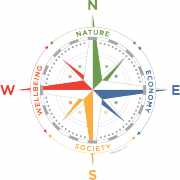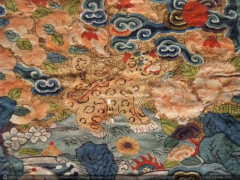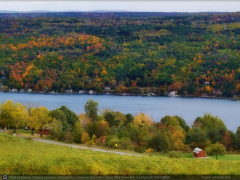“We need to work together to optimize the system as a whole, not to seek to optimize separate pieces… Optimizing separate pieces destroys the effectiveness of the whole. For the organization to work well as a whole, the components must work together.” Brian Joiner
“We don’t accomplish anything in this world alone… and whatever happens is the result of the whole tapestry of one’s life and all the weavings of individual threads from one to another that creates something.” Sandra Day O’Connor
“A composition is always more than the sum of its parts. In other words, a really good piece of music is more than itself. It’s sort of like a prism, which you can see from each facet a single totality.” Yo-Yo Ma
One of the biggest sustainability challenges we face is learning how to see whole systems, everything that contributes to creating what we experience, much of which lays beyond our ready awareness and understanding. We often think we fully know what is happening and why, but this is rarely true.
Margaret Wheatley cites research on human cognition that reveals how much of what we see, think, and reason is predetermined by subconscious filters within our own minds: “Information relayed from the outside through the eyes accounts for only 20% of what we use to create a perception. We each create our own worlds by what we choose to notice…to enact our particular version of reality.” Physicist David Bohm makes a similar point: “[We practice] the almost universal habit of taking the content of our thought for a description of the world as it is.”
I continue to remind myself of this and realize there are many things that I don’t know that I don’t know. I have to fight a tendency to get to an answer – what I hope is a good answer for sure – as quickly as possible. But I too often draw conclusions and decide on solutions based on my own “wisdom,” “knowledge,” and “experience” without making the time to check my assumptions and seek other perspectives.
I think this behavior is common in people and societies and at best results in suboptimal outcomes; at worst, results can be catastrophic. Which is probably why H.L. Mencken wrote: “Explanations exist. They have existed for all times, for there is always an easy solution to every problem – neat, plausible, and wrong.”
Add to that what Adam Kahane points out in his excellent book Solving Tough Problems: that our toughest challenges, like the sustainability challenge of creating a flourishing society that persists into the indefinite future, are complex:
- cause and effect are separated in time and space,
- the people involved see things differently,
- and events tend to unfold – some might say unravel – in unfamiliar and unpredictable ways.
I try to keep in mind this advice from Donella Meadows: “Remember, always, that everything you know, and everything everyone knows, is only a model. Get your model out there where it can be viewed. Invite others to challenge your assumptions and add their own.”
So the models and metaphors we create, refine, and use to make sense of the world are very important, as is our willingness to constantly reexamine and test them. After all, it was unquestioned assumptions that led IBM Chairman Thomas Watson, an acknowledged “expert,” to say in 1943,“I think there is a world market for maybe 5 computers.”
As I mentioned in a column on this subject a year ago, there are several models that attempt to explain sustainability and remind us to think beyond our normal boundaries of awareness. Like all models, each one is useful, and each one has limitations: The Triple Bottom Line, The Natural Step, economist Herman Daly’s Triangle of Means and Ends are a few examples.

We have chosen the Sustainability Compass as our model. The Sustainability Compass was inspired by Daly’s triangle, and came as a spark of inspiration to our friend and sustainability colleague, Alan AtKisson. He describes the moment of creation in his book The Sustainability Transformation (hardback was titled The ISIS Agreement).
In this model, the four cardinal compass points, N, E, S, and W, represent the four system components of a sustainable world: Nature, Economy, Society, and individual Wellbeing:
- a Natural world that is diverse, complex, thriving, where natural processes and conditions are healthy and functioning;
- an Economy that is prosperous, and inclusive, and operating within the laws and limits of nature;
- a Society of caring, connection, diversity, rich in culture and artistic expression, with strong communities and neighborhoods and active citizen engagement;
- a state of Wellbeing for individuals characterized by health, happiness, fulfillment, quality of life.
One of the limitations of the compass model is that it can infer that each of these system components is separate from the others. Even the idea of a compass, providing direction for travel, can subtly infer that travelling toward Wellbeing means travelling away from a vibrant and inclusive Economy. But that is not the intended message of the Sustainability Compass.
For our purposes, the compass serves as a prism, revealing the interrelated components of the system. Nature, the Economy, Society, and Wellbeing are intimately and irrevocably interwoven, like the fabric of a tapestry.
 As a prism the Sustainability Compass helps us see the component parts of a livable world more easily and reminds us that we have to think of the whole system. We cannot limit our attention, concern, and actions to one part of the system while ignoring the rest. Even with the best intentions, what we do in one realm if done without thinking about what is best for the whole, is likely to have negative consequences in other parts of the system.
As a prism the Sustainability Compass helps us see the component parts of a livable world more easily and reminds us that we have to think of the whole system. We cannot limit our attention, concern, and actions to one part of the system while ignoring the rest. Even with the best intentions, what we do in one realm if done without thinking about what is best for the whole, is likely to have negative consequences in other parts of the system.
For example:
Fossil fuels have powered an Industrial Revolution, and for 200 years these fuels have for the most part served us well. Human society has been utterly transformed. The economy has grown exponentially, and for many – but not all – societal conditions and individual wellbeing have improved. For some, social conditions and individual health have declined because of wastes generated and degradation of nature’s functions and services.
In the late 1800s scientists began speculating about the increase of greenhouse gasses in the atmosphere as a result of burning fossil fuels. Would adding more heat-trapping gasses to the atmosphere make any difference, and if so, what kind of difference? For a long time, not many people paid much attention to this question.
In the past few decades, scientists have put substantial and ongoing time, effort, and resources into answering the question, and science has arrived at some definitive answers. Burning fossil fuels has changed and will continue to change the climate. Many questions about climate change remain unanswered, but not the question of whether or not it is happening and what the implications are for humanity.
Overwhelming scientific research has established unequivocally that we are pumping so much carbon dioxide, methane, and other greenhouse gasses into the atmosphere, 98 million tons per day, that we are significantly changing the climate of the planet and threatening the very civilization that has benefitted from the burning of fossil fuels. Kind of ironic.
Whole-system thinking requires us to find ways to power society that have restorative impacts rather than such damaging and accumulating consequences for nature, the economy, society and wellbeing.
 Just recently I learned what makes tapestry a tapestry. It has to do with the way discontinuous horizontal threads are woven across vertical threads, which are hidden from view. This is unlike regular weaving where continuous horizontal threads are interwoven with vertical threads and the vertical threads are typically visible.
Just recently I learned what makes tapestry a tapestry. It has to do with the way discontinuous horizontal threads are woven across vertical threads, which are hidden from view. This is unlike regular weaving where continuous horizontal threads are interwoven with vertical threads and the vertical threads are typically visible.
 This distinctive technique is why tapestries can be so complex and beautiful. In a very real sense the natural world and everything we appreciate about human civilization are tapestries too. Beautiful, complex, wonderful; a bounty of attributes woven together into a magnificent whole. And like a fabric tapestry, all that is good about the natural and built environment is interwoven and dependent on not-so-apparent infrastructure that enables the whole to persist in a healthy state.
This distinctive technique is why tapestries can be so complex and beautiful. In a very real sense the natural world and everything we appreciate about human civilization are tapestries too. Beautiful, complex, wonderful; a bounty of attributes woven together into a magnificent whole. And like a fabric tapestry, all that is good about the natural and built environment is interwoven and dependent on not-so-apparent infrastructure that enables the whole to persist in a healthy state.
The most important considerations in creating a tapestry that lasts are to make sure that the underlying vertical threads, the foundation upon which the image is created, are strong enough to last over time, and to have the skill to weave together high quality horizontal threads in a way that creates a beautiful image. If the vertical threads are weak, or degraded and broken down over time, the tapestry unravels. It won’t matter how much time and effort has been put into weaving the picture together.
When it comes to creating a living tapestry of human civilization that is worth living in and that lasts, the same thing is true. The Sustainability Compass can be used as a tool to identify foundational system support structures and relationships among nature, the economy, society, and wellbeing. Seeing these linkages more clearly, we can reduce and eliminate negative threads and enhance and expand desirable ones.
Providing for the entire system, paying attention to and respecting the interdependent infrastructure of laws, limits, processes, and relationships that enable nature, the economy, society and wellbeing to thrive together, we can weave a magnificent world that lasts.





